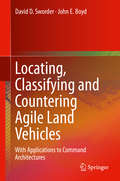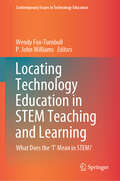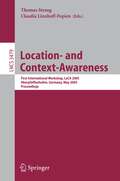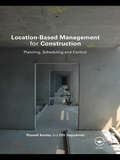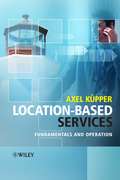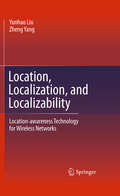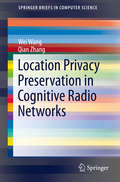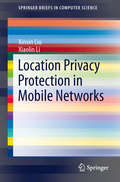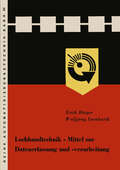- Table View
- List View
Localized Excitations in Nonlinear Complex Systems: Current State of the Art and Future Perspectives (Nonlinear Systems and Complexity #7)
by Ricardo Carretero-González Jesús Cuevas-Maraver Dimitri Frantzeskakis Nikos Karachalios Panayotis Kevrekidis Faustino Palmero-AcebedoThe study of nonlinear localized excitations is a long-standing challenge for research in basic and applied science, as well as engineering, due to their importance in understanding and predicting phenomena arising in nonlinear and complex systems, but also due to their potential for the development and design of novel applications. This volume is a compilation of chapters representing the current state-of-the-art on the field of localized excitations and their role in the dynamics of complex physical systems.
Localized Quality of Service Routing for the Internet (The Springer International Series in Engineering and Computer Science #739)
by Srihari Nelakuditi Zhi-Li ZhangThe exponential growth of Internet brings to focus the need to control such large scale networks so that they appear as coherent, almost intelligent, organ isms. It is a challenge to regulate such a complex network of heterogeneous elements with dynamically changing traffic conditions. To make such a sys tem reliable and manageable, the decision making should be decentralized. It is desirable to find simple local rules and strategies that can produce coherent and purposeful global behavior. Furthermore, these control mechanisms must be adaptive to effectively respond to continually varying network conditions. Such adaptive, distributed, localized mechanisms would provide a scalable so lution for controlling large networks. The need for such schemes arises in a variety of settings. In this monograph, we focus on localized approach to quality of service routing. Routing in the current Internet focuses primarily on connectivity and typi cally supports only the "best-effort" datagram service. The routing protocols deployed such as OSPF use the shortest path only routing paradigm, where routing is optimized for a single metric such as hop count or administrative weight. While these protocols are well suited for traditional data applications such as ftp and telnet, they are not adequate for many emerging applications such as IP telephony, video on demand and teleconferencing, which require stringent delay and bandwidth guarantees. The "shortest paths" chosen for the "best effort" service may not have sufficient resources to provide the requisite service for these applications.
Localized Surface Plasmon Resonance Based Nanobiosensors (SpringerBriefs in Molecular Science)
by Yi-Tao Long Chao JingThis book introduces the fundamentals and applications of the localized surface plasmon resonance (LSPR) property of noble metallic nanoparticles, with an emphasis on the biosensing applications of plasmonic nanoparticles, especially in living cell imaging and photothermal therapy. It provides an overview of the different operating principles of plasmonic sensors, particularly the single-nanoparticle-based detections, and a series of creative biosensors based on the modulation of different parameters of nanoparticles (particle size, shape, composition and surrounding medium) for label-free detection. The interparticle coupling effect, plasmon resonance energy transfer, electron transfer on plasmonics surface are also covered in this book.This book is intended for graduate students and researchers working in the interdisciplinary field combining chemistry, biology, material science and nanophotonics.Yi-Tao Long is a Professor at the School of Chemistry and Molecular Engineering, East China University of Science and Technology, China.
Locally Relevant ICT Research: 10th International Development Informatics Association Conference, IDIA 2018, Tshwane, South Africa, August 23-24, 2018, Revised Selected Papers (Communications in Computer and Information Science #933)
by Filistea Naude Marita Turpin Kirstin KraussThis book constitutes the refereed proceedings of the 10th International Development Informatics Association Conference, IDIA 2018, held in Tshwane, South Africa, in August 2018.The 20 revised full papers presented were carefully reviewed and selected from 61 submissions. The papers are organized in topical sections on ICT adoption and impact; mobile education; e-education; community development; design; innovation and maturity; data.
Locating, Classifying and Countering Agile Land Vehicles: With Applications to Command Architectures
by David D. Sworder John E. BoydThis book examines real-time target tracking and identification algorithms with a focus on tracking an agile target. The authors look at several problems in which the tradeoff of accuracy and confidence must be made. These issues are explored within the context of specific tracking scenarios chosen to illustrate the tradeoffs in a simple and direct manner. The text covers the Gaussian wavelet estimator (GWE) which has a flexible architecture that is able to fuse uncommon sensor combinations with non-temporal structural constraints.
Locating Technology Education in STEM Teaching and Learning: What Does the ‘T’ Mean in STEM? (Contemporary Issues in Technology Education)
by Wendy Fox-Turnbull P. John WilliamsThis book offers clarity and consistency of thinking in relation to Technology Education when situated within a STEM approach to teaching. It examines the range of Innovations and Issues which are being considered by schools as they implement STEM, with particular focus on the place of Technology, or the ‘T’ in STEM. The book is divided into three sections: Philosophy, Implementation and Issues and Innovations, with each containing five to seven chapters. The first section lays the foundations for the remainder of the book: it focuses the readers on the technology aspect of STEM education and situates it to align with the international understanding of technology education. The second section provides insights into how STEM is best implemented to give technology due consideration across a range of disciplines with technology education, including engineering, food technology, and textile technology. This section also provides suggestions for the successful implementation of the STEM approach, and offers further insight through a range of case studies. The third section outlines and discusses a range of issues that pose a threat to the position and understanding of technology within the STEM teaching and learning approach. This section also examines how technology and STEM are situated within, are supported or are threatened by, other current innovations and approaches to teaching an integrated curriculum, such as the Maker Space Movement and Play-based Learning.
Location and Context Awareness: 4th International Symposium, LoCA 2009 Tokyo, Japan, May 7-8, 2009 Proceedings (Lecture Notes in Computer Science #5561)
by Tanzeem Choudhury Aaron Quigley Thomas Strang Koji SuginumaThese proceedings contain the papers presented at the 4th International S- posium on Location and Context Awareness (LoCA) during May 7–8, 2009 in Tokyo,Japan.Locationandcontextawarenessarefundamentstonext-generation mobile and pervasive computing systems. Pervasive computing is a model of computing in which computation is everywhere and computer functions are - tegrated into everything. The ultimate aim is to make information, applications and services available anywhere and at anytime in the human environment in a ?uid manner appropriate to our current context. Once away from the desktop, we ?nd ourselves in a wide variety of contexts and hence situations. For computing to be relevant and useful in these emerging situations we must rely on a range of contextual cues. Context includes phys- logical, environmental, and computational data, whether sensed or inferred. In addition, context includes details of a user’s activities, goals, abilities, pref- ences, a?ordances, and surroundings. With location and context awareness we can expect computers to deliver information, services, and entertainment in a way that maximizes convenience and minimizes intrusion.
Location- and Context-Awareness: First International Workshop, LoCA 2005, Oberpfaffenhofen, Germany, May 12-13, 2005, Proceedings (Lecture Notes in Computer Science #3479)
by Thomas Strang Claudia Linnhoff-PopienContext-awareness is one of the drivers of the ubiquitous computing paradigm. Well-designed context modeling and context retrieval approaches are key p- requisites in any context-aware system. Location is one of the primary aspects of all major context models — together with time, identity and activity. From the technical side, sensing, fusing and distributing location and other context information is as important as providing context-awareness to applications and services in pervasive systems. Thematerialsummarizedinthisvolumewasselectedforthe1stInternational Workshop on Location- and Context-Awareness (LoCA 2005) held in coope- tion with the 3rd International Conference on Pervasive Computing 2005. The workshop was organized by the Institute of Communications and Navigation of the German Aerospace Center (DLR) in Oberpfa?enhofen, and the Mobile and Distributed Systems Group of the University of Munich. During the workshop, novel positioning algorithms and location sensing te- niques were discussed, comprising not only enhancements of singular systems, like positioning in GSM or WLAN, but also hybrid technologies, such as the integration of global satellite systems with inertial positioning. Furthermore, - provements in sensor technology, as well as the integration and fusion of sensors, were addressed both on a theoretical and on an implementation level. Personal and con?dential data, such as location data of users, have p- found implications for personal information privacy. Thus privacy protection, privacy-oriented location-aware systems, and how privacy a?ects the feasibility and usefulness of systems were also addressed in the workshop.
Location and Postproduction Sound for Low-Budget Filmmakers
by Michael TiernoThis book covers everything you need to know to master the fundamentals of location sound recording and postproduction sound in a comprehensive one-stop guide. This user-friendly book provides real world situations to analyze the many kinds of location recording configurations and postproduction scenarios and offers easy-to-adopt, budget-conscious solutions to some of the most common issues that arise when working with sound. Chapters cover the theory of sound, preproduction with a sound emphasis, microphone selection, testing equipment, how to boom and mix on set, synchronization and time code, and editing sound while doing a picture cut in a traditional picture software platform. Additionally, the book discusses bringing a project into a Digital Audio Workstation and explores basic sound design, dialogue editing, Automated Dialogue Replacement, Foley, sound effects, music for film, re-recording the final mix, and outputting sound to finish a project. Accompanying examples allow readers the opportunity to try out the various techniques and drills on location, in postproduction, or both. Aimed at students, early career and independent filmmakers, as well as those considering a vocation in location and postproduction sound, Location and Postproduction Sound for Low-Budget Filmmakers makes achieving great sound attainable for all, and is an invaluable tool for anyone wanting to better understand the art of film sound.
Location and Postproduction Sound for Low-Budget Filmmakers
by Michael TiernoThis book covers everything you need to know to master the fundamentals of location sound recording and postproduction sound in a comprehensive one-stop guide. This user-friendly book provides real world situations to analyze the many kinds of location recording configurations and postproduction scenarios and offers easy-to-adopt, budget-conscious solutions to some of the most common issues that arise when working with sound. Chapters cover the theory of sound, preproduction with a sound emphasis, microphone selection, testing equipment, how to boom and mix on set, synchronization and time code, and editing sound while doing a picture cut in a traditional picture software platform. Additionally, the book discusses bringing a project into a Digital Audio Workstation and explores basic sound design, dialogue editing, Automated Dialogue Replacement, Foley, sound effects, music for film, re-recording the final mix, and outputting sound to finish a project. Accompanying examples allow readers the opportunity to try out the various techniques and drills on location, in postproduction, or both. Aimed at students, early career and independent filmmakers, as well as those considering a vocation in location and postproduction sound, Location and Postproduction Sound for Low-Budget Filmmakers makes achieving great sound attainable for all, and is an invaluable tool for anyone wanting to better understand the art of film sound.
Location Awareness in the Age of Google Maps
by Rebecca NooneLocation Awareness in the Age of Google Maps explores the mundane act of navigating cities in the age of digital mapping infrastructures.Noone follows the frictions routing through Google Maps’ categorising and classifying of spatial information. Complicating the assumption that digital maps distort a sense of direction, Noone argues that Google Maps’ location awareness does more than just organise and orient a representation of space—it also organises and orients imaginaries of publicness, selfsufficiency, legibility, and error. At the same time, Location Awareness in the Age of Google Maps helps to animate the ordinary ways people are challenging and refusing Google Maps’ vision of the world. Drawing on an arts-based field study spanning the streets of London, New York, London, Toronto, and Amsterdam, Noone’s encounters of "asking for directions" open up lines of inquiry and spatial scores that cut through Google‘s universal mapping project.Location Awareness in the Age of Google Maps will be essential reading for information studies and media studies scholars and students with an interest in embodied information practices, critical information studies, and critical data studies. The book will also appeal to an urban studies audience engaged in work on the digital city and the datafication of urban environments.
Location Awareness in the Age of Google Maps
by Rebecca NooneLocation Awareness in the Age of Google Maps explores the mundane act of navigating cities in the age of digital mapping infrastructures.Noone follows the frictions routing through Google Maps’ categorising and classifying of spatial information. Complicating the assumption that digital maps distort a sense of direction, Noone argues that Google Maps’ location awareness does more than just organise and orient a representation of space—it also organises and orients imaginaries of publicness, selfsufficiency, legibility, and error. At the same time, Location Awareness in the Age of Google Maps helps to animate the ordinary ways people are challenging and refusing Google Maps’ vision of the world. Drawing on an arts-based field study spanning the streets of London, New York, London, Toronto, and Amsterdam, Noone’s encounters of "asking for directions" open up lines of inquiry and spatial scores that cut through Google‘s universal mapping project.Location Awareness in the Age of Google Maps will be essential reading for information studies and media studies scholars and students with an interest in embodied information practices, critical information studies, and critical data studies. The book will also appeal to an urban studies audience engaged in work on the digital city and the datafication of urban environments.
Location-Based Management for Construction: Planning, scheduling and control
by Russell Kenley Olli SeppänenWith extensive case studies for illustration, this is a practitioner's guide to an entirely new production system for construction management using flowline scheduling. Covering the entire process of presenting a comprehensive management system – from design, through measurement, scheduling, and visualization and control – its emphasis is on reducing cost and increasing quality. Drawing its components together into a management system, the authors not only include theory and explanations of how and why it works, but also examine and present a suite of methods for successful project implementation. Perfect as a how-to guide for researchers and advanced construction students to discover the simple application of the new techniques, and invaluable for acquiring the practical tools for planning and controlling projects.
Location-Based Management for Construction: Planning, scheduling and control
by Russell Kenley Olli SeppänenWith extensive case studies for illustration, this is a practitioner's guide to an entirely new production system for construction management using flowline scheduling. Covering the entire process of presenting a comprehensive management system – from design, through measurement, scheduling, and visualization and control – its emphasis is on reducing cost and increasing quality. Drawing its components together into a management system, the authors not only include theory and explanations of how and why it works, but also examine and present a suite of methods for successful project implementation. Perfect as a how-to guide for researchers and advanced construction students to discover the simple application of the new techniques, and invaluable for acquiring the practical tools for planning and controlling projects.
Location-Based Services: Fundamentals and Operation
by Axel KüpperLocation-based Services (LBSs) are mobile services for providing information that has been created, compiled, selected or filtered under consideration of the users’ current locations or those of other persons or mobile devices. Typical examples are restaurant finders, buddy trackers, navigation services or applications in the areas of mobile marketing and mobile gaming. The attractiveness of LBSs is due to the fact that users are not required to enter location information manually but are automatically pinpointed and tracked. This book explains the fundamentals and operation of LBSs and gives a thorough introduction to the key technologies and organizational procedures, offering comprehensive coverage of positioning methods, location protocols and service platforms, alongside an overview of interfaces, languages, APIs and middleware with examples demonstrating their usage. Explanation and comparison of all protocols and architectures for location services In-depth coverage of satellite, cellular and local positioning All embracing introduction to 3GPP positioning methods, such as Cell-Id, E-OTD, U-TdoA, OTDoA-IPDL and Assisted GPS Explains the operation of enhanced emergency services such as E-911 Identifies unsolved research issues and challenges in the area of LBSs This comprehensive guide will be invaluable to undergraduate and postgraduate students and lecturers in the area of telecommunications. It will also be a useful resource to developers and researchers seeking to expand their knowledge in this field.
Location, Localization, and Localizability: Location-awareness Technology for Wireless Networks
by Yunhao Liu Zheng YangThis book reflects up-to-date research, fundamental theories, and key techniques of of wireless localization technology and error-controlling techniques. It also presents and discusses the issue of localizability, as well as privacy issues associated with LBS. This book encompasses the significant and quickly growing area of wireless localization technology. It presents comprehensive and up-to-date research in both fundamental theories and key techniques of network localization. In addition to localization approaches, it also is the first book to address the issue of localizability. The privacy issue of LBS technology is also discussed.
Location, Localization, and Localizability: Location-awareness Technology for Wireless Networks
by Yunhao Liu Zheng YangTime flies since the debut of this book. In the past ten years, localization technology has evolved from small saplings into towering trees. Robots and drones with autonomous positioning and navigation capabilities, once considered unreachable fantasies, have gradually become a reality. However, while we are being amazed at the groundbreaking changes brought about by technology, as researchers, we still need to remain acutely attentive to the current limitations of localization. Some significant challenges still impede the widespread deployment. For example, traditional Wi-Fi fingerprint-based wireless localization, due to various challenges in fingerprint database collection and maintenance, has remained stay in the laboratory, and even when using smartphones for localization in malls, we still cannot achieve the outdoor GPS-like experience. The list goes on and on. Against this backdrop, the reissue of this book aims to more comprehensively reflect the latest developments in localization technology. We have added introductions to emerging technologies such as passive high-precision localization based on wireless signal CSl and autonomous localization for smart devices. Additionally, we have integrated and further streamlined technical chapters that now appear outdated adapting to the pace of the times. This book aims to provide a comprehensive and in-depth view of location-awareness technology in today’s popular wireless networks. However, the obvious diversity of networks, from short-range Bluetooth to long-range telecommunication networks, makes it very challenging to organize materials. Although general principles exist, the implementation differs from network to network and application to application. The book can serve as a guidebook for the technicians and practitioners in the industry of location systems. They can expect to obtain a comprehensive understanding of the field, in order to compare and select localization solutions fulfilling various application requirements. Abundant references in the book open up a broader domain for advanced study. In addition, the book is tailored toward a textbook for college researchers and graduate students.
Location Privacy Preservation in Cognitive Radio Networks (SpringerBriefs in Computer Science)
by Wei Wang Qian ZhangThis brief focuses on the current research on location privacy preservation in cognitive radio networks (CRNs). Along with a review of the existing works, this book includes fundamental privacy models, possible frameworks, useful performance, and future research directions. It explores privacy preservation techniques, collaborative spectrum sensing, database-driven CRNS, and modeling potential privacy threats. Conflicts between database owners and unlicensed users can compromise location privacy, and CRNs are a means to mitigate the spectrum scarcity issue due to the increasing demand for wireless channel resources. By examining the current and potential privacy threats, the authors equip readers to understand this developing issue. The brief is designed for researchers and professionals working with computer communication networks and cognitive radio networks. Graduate students interested in networks and communication engineering will also find the brief helpful.
Location Privacy Protection in Mobile Networks (SpringerBriefs in Computer Science)
by Xinxin Liu Xiaolin LiThis SpringerBrief analyzes the potential privacy threats in wireless and mobile network environments, and reviews some existing works. It proposes multiple privacy preserving techniques against several types of privacy threats that are targeting users in a mobile network environment. Depending on the network architecture, different approaches can be adopted. The first proposed approach considers a three-party system architecture where there is a trusted central authority that can be used to protect users’ privacy. The second approach considers a totally distributed environment where users perform privacy protection by themselves. Finally, more general system architecture is discussed including how a semi-trusted server may exist, but users need to collaborate to achieve maximized privacy protection. This brief is designed for researchers and professionals working with privacy preservation, mobile networks, and threat models. The variety of approaches presented makes it useful for students as well.
Location Strategies: International Site and Facility Planning as part of Corporate Strategies
by Thomas GlatteThis books covers new aspects of location strategies and site selection through globalization. It elaborates real estate specific requirements to the planning and analysis process of industrial corporations in an international environment. It explains methods relevant for professionals in the field and discusses in detail an extensive list of site selection criterias. The book is built on existing and broadly recognized research and accelerates this know-how in an real reastate and international context. The challenges for location strategies as well as management alternatives for practitioners are shown and explained through practical examples.
Location Systems: An Introduction to the Technology Behind Location Awareness (Synthesis Lectures on Mobile & Pervasive Computing)
by Anthony LaMarca Eyal de LaraAdvances in electronic location technology and the coming of age of mobile computing have opened the door for location-aware applications to permeate all aspects of everyday life. Location is at the core of a large number of high-value applications ranging from the life-and-death context of emergency response to serendipitous social meet-ups. For example, the market for GPS products and services alone is expected to grow to US$200 billion by 2015. Unfortunately, there is no single location technology that is good for every situation and exhibits high accuracy, low cost, and universal coverage. In fact, high accuracy and good coverage seldom coexist, and when they do, it comes at an extreme cost. Instead, the modern localization landscape is a kaleidoscope of location systems based on a multitude of different technologies including satellite, mobile telephony, 802.11, ultrasound, and infrared among others. This lecture introduces researchers and developers to the most popular technologies and systems for location estimation and the challenges and opportunities that accompany their use. For each technology, we discuss the history of its development, the various systems that are based on it, and their trade-offs and their effects on cost and performance. We also describe technology-independent algorithms that are commonly used to smooth streams of location estimates and improve the accuracy of object tracking. Finally, we provide an overview of the wide variety of application domains where location plays a key role, and discuss opportunities and new technologies on the horizon. Table of Contents: Introduction / The Global Positioning System / Infrared and Ultrasonic Systems / Location Esimation with 802.11 / Cellular-Based Systems / Other Approaches / Improving Localization Accuracy / Location-Based Applications and Services / Challenges and Opportunities / References
Location Theory and Decision Analysis: Analytics of Spatial Information Technology
by Yupo ChanEmploying state-of-the art quantitative models and case studies, Location Theory and Decision Analysis provides the methodologies behind the siting of such facilities as transportation terminals, warehouses, housing, landfills, state parks and industrial plants. Through its extensive methodological review, the book serves as a primer for more advanced texts on spatial analysis, including the monograph on Location, Transport and Land-Use by the same author. Given the rapid changes over the last decade, the Second Edition includes new analytic contributions as well as software survey of analytics and spatial information technology. While the First Edition served the professional community well, the Second Edition has substantially expanded its emphasis for classroom use of the volume. Extensive pedagogic materials have been added, going from the fundamental principles to open-ended exercises, including solutions to selected problems. The text is of value to engineering and business programs that offer courses in Decision and Risk Analysis, Muticriteria Decision-Making, and Facility Location and Layout. It should also be of interest to public policy programs that use geographic Information Systems and satellite imagery to support their analyses.
Location, Transport and Land-Use: Modelling Spatial-Temporal Information
by Yupo Chan1. Theme and focus Few books are available to integrate the models for facilities siting, transportation, and land-use. Employing state-of-the-art quantitative-models and case-studies, this book would guide the siting of such facilities as transportation terminals, warehouses, nuclear power plants, military bases, landfills, emergency shelters, state parks, and industrial plants. The book also shows the use of statistical tools for forecasting and analyzing implications of land-use decisions. The idea is that la- use on a map is necessarily a consequence of individual, and often conflicting, siting decisions over time. Since facilities often develop to form a community, these decisions are interrelated spatially—i. e. , they need to be accessible to one another via the transportation system. It is our thesis that a common methodological procedure exists to analyze all these spatial-temporal constructs. While there are several monographs and texts on subjects related to this book's, this volume is unique in that it integrates existing practical and theoretical works on facility-location, transportation, and land-use. Instead of dealing with individual facility-location, transportation, or the resulting land-use pattern individually, it provides the underlying principles that are behind these types of models. Particularly of interest is the emphasis on counter-intuitive decisions that often escape our minds unless deliberate steps of analysis are taken. Oriented toward the fundamental principles of infrastructure management, the book transcends the traditional engineering and planning disciplines, where the main concerns are often exclusively either physical design, fiscal, socioeconomic or political considerations.





